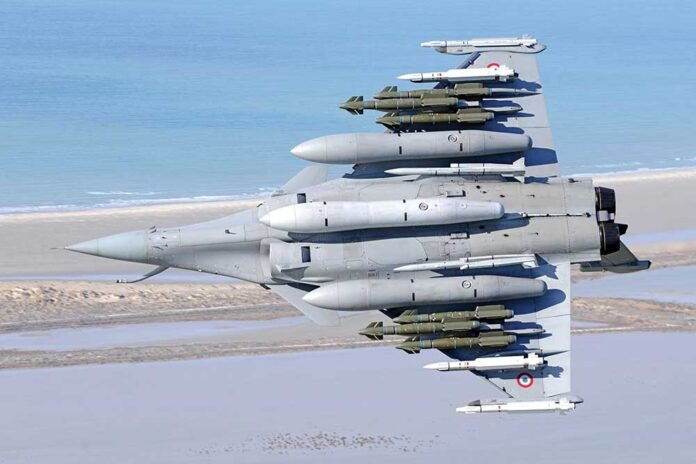Asia’s biggest air show, Aero India 2025, is all set to take place at the Air Force Station, Yelahanka, on the outskirts of Bengaluru, Karnataka, from February 10 to 14, 2025. This marks the 15th edition of India’s premier biennial airshow, which began in 1996 and has since been held consistently with increasing grandeur and prominence.
This year’s event is being organised by the Ministry of Defence’s (MoD) Defence Exhibition Organisation (DEO) under the tagline ‘Runway to a Billion Opportunities’. The focus is on forging new partnerships and exploring avenues to accelerate the indigenisation process in the aerospace sector. Previous editions of the airshow have similarly been framed with lofty aspirations, often evaluated more in terms of statistical achievements than tangible outcomes.
If past records are anything to go by, DEO is poised to add another feather to its cap. The 2023 edition saw over 700,000 visitors from 98 countries, with 809 exhibitors, including businesses, investors, start-ups, and MSMEs, participating in various events. Representatives from 27 countries attended the Indian Ocean Region (IOR) and Defence Ministers’ Conclave, while 53 aircraft showcased their capabilities.
On the commercial front, more than 250 Memorandums of Understanding (MoUs) and partnerships worth over ₹75,000 crore were finalised, with ₹200 crore pledged at the maiden iDEX Investor Hub (iIH). The iDEX (Innovation for Defence Excellence) is an MoD-sponsored initiative aimed at encouraging start-ups and innovators to tackle complex defence challenges, supported by limited funding from the MoD.
There is little reason to doubt that this year’s numbers will match or even surpass previous benchmarks. While these figures are a valid measure of the event’s scale and success, they reveal little about how many of the MoUs signed in earlier editions led to the commencement of production or how much of the promised investments were realised in the subsequent years.
While it would be unfair to undermine the intent or the effort involved in organising such a colossal event, its true impact should be assessed in terms of its contribution to enhancing the Indian Air Force’s (IAF) combat capabilities. This is where the situation becomes less promising.
The IAF currently operates 30 fighter squadrons, far short of the sanctioned strength of 42 squadrons. This sanctioned figure, determined decades ago, has remained unchanged despite the induction of more advanced fighter aircraft, the acquisition of drones and missiles, and ongoing efforts to promote jointness in military operations.
Despite ambitious slogans and record-breaking participation numbers, Aero India 2025 faces tough questions about its impact on strengthening India’s defence capabilities. With production delays in the Tejas programme and dependence on foreign engines, the road to self-reliance appears fraught with turbulence
That said, there is no denying the mismatch between India’s air combat capabilities and those of its adversaries, particularly China. The IAF’s most advanced aircraft, the 4.5th generation Rafale, is represented by just two squadrons.
In contrast, China is significantly ahead. It already operates 5th generation Chengdu J-20 and Shenyang J-35 stealth fighters and, on December 26, 2024, conducted the maiden test flights of two 6th generation stealth fighter jets in Chengdu. India’s 5th generation Advanced Medium Combat Aircraft (AMCA) project, meanwhile, remains at least a decade from completion. By the time it materialises, China is likely to have advanced even further.
The HAL-built Light Combat Aircraft (LCA) Tejas is expected to become the backbone of the IAF in the coming years. However, both its variants, Mk-1A and Mk-2, face persistent challenges. These range from design issues and production rates to delays in the supply of F404-IN20 engines by the US-based General Electric. This has directly impacted the production of the Tejas Mk-1A. Furthermore, the deal with General Electric for the transfer of technology to co-produce the F414 INS6 engine, which is to power the Tejas Mk-2, appears to be experiencing inexplicable delays.
Delivering the keynote address at the 21st Subroto Mukerjee Seminar in New Delhi on 7 January 2025, Air Chief Marshal A.P. Singh highlighted the security challenges India faces due to the increasing militarisation by China and Pakistan, the extremely slow pace of delivery of the indigenous Tejas aircraft, and the Defence R&D’s inability to meet timelines for developing cutting-edge technologies.
While promoting local production of defence equipment and defence exports will undoubtedly contribute to the defence industry’s growth, it will provide only limited assistance in equipping the Indian Air Force (IAF) with the requisite capabilities within the desired timeframe. More importantly, unless Defence R&D is prioritised over co-production initiatives involving technology transfers from abroad, self-reliance in the true sense will remain an elusive goal.
This issue is exemplified by the case of the IAF’s future workhorse, the Tejas. The aircraft remains critically dependent on foreign-origin engines, and disruptions in its supply chain have significantly impacted production timelines. Additionally, concerns persist regarding Hindustan Aeronautics Limited’s (HAL) capacity to meet the IAF’s requirement for 180 Tejas Mk-1A and 108 Tejas Mk-2 aircraft within the desired timeframe, even if the ongoing engine supply issues are resolved promptly.
The HAL-built Light Combat Aircraft (LCA) Tejas is expected to become the backbone of the IAF in the coming years. However, both its variants, Mk-1A and Mk-2, face persistent challenges. These range from design issues and production rates to delays in the supply of F404-IN20 engines by the US-based General Electric
The private sector’s involvement in Defence R&D remains marginal, despite the Union Budget announcement for FY 2022-23, which earmarked 25% of the defence R&D budget for private industry and start-ups to foster innovation in defence technologies. The reasons for this limited involvement remain unclear, as no substantial effort has been made to identify and address the root causes.
Moreover, procurement policies and procedures continue to be complex and inherently resistant to swift decision-making. For instance, less than a year after the Defence Acquisition Procedure 2020 was introduced, the then recently retired Army Chief, General Manoj Naravane, criticised the “overbearing nature of our rules and regulations” and called for a “revolution in bureaucratic affairs.”
The objectives of Aero India 2025 would be better served by focusing on these systemic issues in the numerous meetings and conferences scheduled during the event. However, it remains doubtful that sessions such as the CEOs’ Round Table, iDEX Start-up Event, and the Defence Ministers’ Conclave, cryptically titled ‘BRIDGE – Building Resilience through International Defence and Global Engagement,’ will provide adequate space for discussing the real challenges facing the IAF.
That said, the agenda does include some bilateral ministerial and official meetings with participating industry representatives. These informal brainstorming sessions offer a valuable opportunity to generate out-of-the-box ideas for tackling the enduring problems of military modernisation and self-reliance. Such informal exchanges often prove more fruitful than rigid, formal information-gathering exercises.
–The writer is a former Financial Advisor (Acquisition), Ministry of Defence. The views expressed are personal and do not necessarily reflect the views of Raksha Anirveda

















